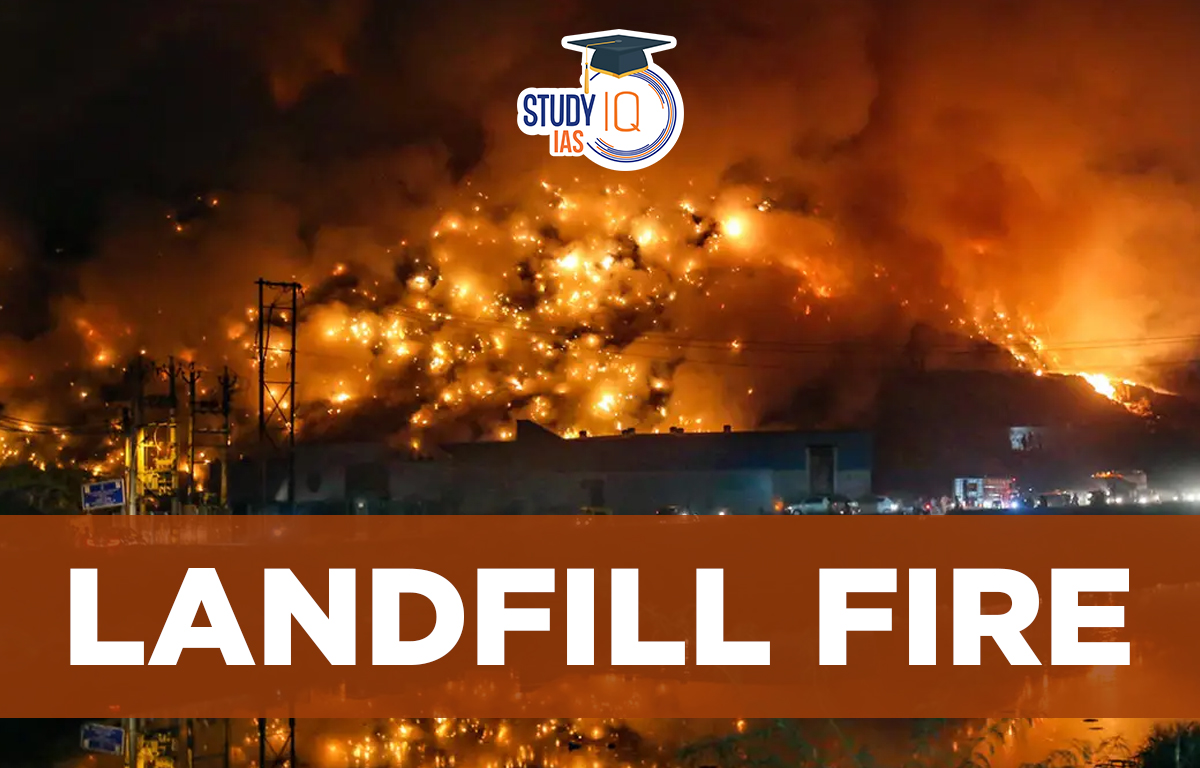Table of Contents
Context: A major fire broke out at the landfill site of the Kochi Corporation.
Background: Landfill Menace in India
- Landfills are low-lying areas that are used for the disposal of waste materials.
- According to the Swachh Bharat report (2020), India loses over 1,250 hectares of useful land every year to dispose of municipal solid waste.
- According to National Green Tribunal, more than 10,000 hectares of usable urban land is locked up under 3,159 legacy waste dumpsites in the country.
About Landfill Fire
- Landfill fires are one of the more visible consequences of poor waste management.
- Landfill Constitutes: The Solid Waste Management Rules issued by the Ministry of Environment, Forest and Climate Change in 2016 state that only non-recyclable, non-biodegradable and non-combustible waste should go to a sanitary landfill.
- Process of Landfill Catching Fire: Since landfill sites receive mixed wastes which include organic waste as well as ignitable material and plastics.
- The biodegradable or food waste decomposes over time.
- The anaerobic decomposition (breakdown of organic waste in the absence of oxygen) of organic waste generates methane gas and heat.
- As soon as the methane gas comes in contact with oxygen, the combustible materials at the dumping site catch fire easily.
- Methane emission: Landfills are the largest source of methane emissions.
- Methane is highly flammable and plays a large role in the ignition of landfill fires.

Reasons for Landfills Catching Fire Easily
- Lack of Processing: India’s municipalities have been collecting more than 95% of the waste generated in cities but the efficiency of waste-processing is 30-40%.
- Rate of processing in India’s cities is far lower than the rate of waste generation, so unprocessed waste remains in open landfills for long periods.
- Flammable Material: Disposed waste contains flammable material like low-quality plastics. In summer, the biodegradable fraction composts much faster, increasing the temperature of the heap to beyond 70-80° C.
- Higher temperature – flammable material = a chance for the landfill to catch fire.

Effects of Landfill Fires
- Impact on health: Landfill fires can produce toxic smoke and gases. These fumes can affect the health of residents of the area.
- Air pollution: Landfill fires consist of particulate matter, which mixes with the air and degrades its quality.
- Water pollution: Water used in dousing landfill fires can create leachate pools, which can mix with nearby water body affecting its quality. Fires can also destroy underlying membrane, which is necessary to prevent pollution of groundwater.
Way Forward
- Source segregation: Waste segregation at the source is critical to ensure that waste can be diverted to different recycling facilities.
- Dry waste recycling: The segregated dry waste can be processed in decentralised material recovery facilities.
- Mandatory Biomining of Waste: Biomining is the scientific process of excavation, treatment, segregation and gainful utilisation of aged municipal solid waste lying in dumpsites typically referred to as legacy waste.
- The methods of biomining include Bioleaching, Bio-oxidation, Dump leaching, and Agitated leaching.
- Conversion into bio-compressed natural gas (CNG): Bio-CNG plants can produce biogas from the waste present in landfill sites.
- Scientific Disposition of Waste: Scientifically designed landfills are expected to have leachate collection systems and gas collection systems, while the waste is to be compacted properly and pathways are to be provided through the dumpsite.
- Bioremediation: Old waste can be segregated using automated sieving machines to segregate plastics, rags, clothes, etc., from biodegradable material.
- Adopt a zero-landfill model: It identifies a “zero-landfill city” as one that ensures maximum quantities of waste are subjected to scientific treatment and recycling.


 UPPSC Previous Year Question Papers, Dow...
UPPSC Previous Year Question Papers, Dow...
 Most Commonly Used Cancer Drugs and Thei...
Most Commonly Used Cancer Drugs and Thei...
 Tansen Biography, Musical Legacy and Mas...
Tansen Biography, Musical Legacy and Mas...





















